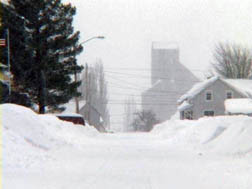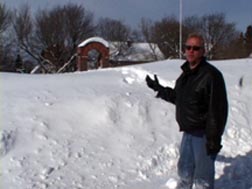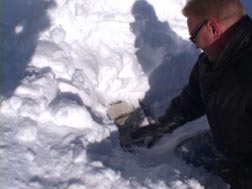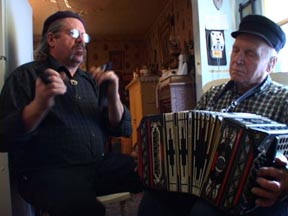It’s been a busy winter, and this update is long overdue.
We returned to the UP in late February, in search of snow and to complete principal photography on the Calumet story. We’dd been to Calumet in December, but everybody there told us that if we really wanted to see Calumet in the snow, we’d have to come in February. Over 300 inches had fallen already this winter, and on the first few days of our trip we were sure that we were in for it. It snowed and it blew; it was cold and everything was white. But by the time we met up with Joe Chevalier and his crew, who took us out on snow removal duty around town, the weather had turned surprisingly mild — getting up into the teens most days.
Just to remind everybody that winter is not over, Lake Superior dumped nearly 40 inches of snow on Calumet just the other day. Unfortunately, we’d returned to the east coast by then. Still, we managed to see a side of Calumet that we hadn’t seen.


We started our trip in Marquette, where it was snowing hard (but not really snowing, or at least not really hard, according to our friends in Calumet). Jack Deo invited us to work with his great collection of archival photographs at Superior View. The next day, we kicked off our post-production fundraising drive with a presentation about the film at the annual meeting of the Marquette County Labor Council. What better audience for our film than a UP labor audience? We’re indebted to Kathy Carlson for all her hard work putting the day together, and to Shana Harvala and the Labor Council for having us.
(If you’d like to find out how we can make a presentation about the film to your organization, or to make a tax-deductible contribution to the project, please contact us .)
On this trip we also spent time with attorney and author Steve Lehto, who has recently completed a book about the Italian Hall disaster entitled Death’s Door (forthcoming from Momentum Books). We visited the Italian Hall site together, then retreated to the warmth of Tom Tikkanen’s real estate office for a sit down interview, where we talked about the goings on in the Hall on Christmas Eve, 1913, the purloined film of the Italian Hall funeral, and the mournful Cornish chants sung by grieving miners in the funeral procession.


The snow at the arch was pretty deep. And everything in Calumet in February is different: the light is different, and especially beautiful at sunset; there’s a kind of late winter mood in the town, where people have been coping for months with the snow and the cold. Tim Bies and Jeannie Grathoff told us ghost stories; in the Antenna Store on Oak Street, we talked with Gerry Mantel and Pete Oikarinen about how the town’s changed, and about our sense that in Calumet there are still traces of an America that has nearly vanished. Pete’s beautiful black and white photographs of Calumet people perfectly illustrated the point.
The winter sun cast a warm light through the kitchen window shades when we sat down again with John Perona and Randy Seppala to play some music with the concertina and the bones and spoons and to talk about the tradition of Finnish, Cornish, Italian and Croatian music in the area.

Johnny even treated us to a few tunes on the mandolin, and showed us his remarkable collection of UP butterflies and moths, which he’s been capturing and mounting since the late 1930s.

We continued the musical conversation when we visited Oren Tikkanen, who told us stories about UP music and played his mandolins. Even now we can’t get Oren’s rendition of “Mary’s Mazurka” out of our heads. Mary’s Mazurka
